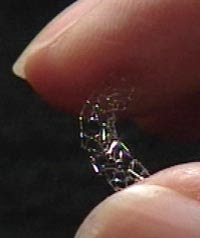Jeffrey W. Moses, M.D. et al. "Sirolimus-Eluting Stents versus Standard Stents in Patients with Stenosis in a Native Coronary Artery." New England Journal of Medicine. 349. (2003): 1315-23.
http://content.nejm.org/cgi/content/full/349/14/1315
As has been previously discussed, the clinical usefulness of coronary stents in percutaneous revascularization is undeniable. They have proven to be more effective than balloon angioplasties due to procedural safety and reduced rates of restenosis. This study confirms what was found in the previous post with regards to the use of drug-eluting stents as a solution to the problem of restenosis.
The study, conducted by Jeffrey W. Moses, M.D. et al at the Lenox Hill Heart and Vascular Institute of New York City, seeks to verify preliminary reports of successful reduction in restenosis by sirolimus-eluting stents. There has been evidence since the early to mid-1900s of sirolimus as a potential inhibitor of the proliferation of vascular smooth-muscle cells and therefore, also an inhibitor of coronary-artery restenosis. (Marks) But there have been relatively few conclusive studies thus far. This trial was important procedurely because it was a randomized, doubleblind comparison of sirolimus-eluting stents(SES) and the standard bare metal stent (BMS) in patients newly diagnosed with lesions in the native coronary artery. In additional to its better design, it followed patients for a longer period of time and patients involved were afflicted with more complicated and challenging conditions such as higher frequency of cardiac risk factors (especially diabetes), more complex lesion morphology, and longer lesions. In short, it better imitated typical patients found in clinical practice.
Even with the increased complexity of the patients’ health conditions, the study found that sirolimus-eluting stents are indeed more effective and less harmful than the standard. The study demonstrated a suppression of in-stent neointimal hyperplasia, the abnormal growth of new tissue over a stent. There were no untoward angiographic complications such as late aneurysms. Finally, the rates of adverse clinical events such as thromboses were not significantly higher in the sirolimus-eluting stent group than in the standard stent-group.
These results indicate that sirolimus-eluting stents simultaneously preserve the safety of stenting procedures while improving the efficacy. This gives us hope that this success will lead to further innovations and technologies in the realm of coronary therapy in the future.


No comments:
Post a Comment